Submitted:
16 February 2023
Posted:
17 February 2023
You are already at the latest version
Abstract
Keywords:
1. Introduction
2. Data and methods
3. Results and Discussion
3.1. Ground concentration and spatial pattern of BC during the wildfires
3.2. Vertical distribution and transport of BC
3.3. Radiative forcing
4. Conclusion
Supplementary Materials
Author Contributions
Funding
Data Availability Statement
Acknowledgments
Conflicts of Interest
Appendix 1
A.1 Surface meteorological prediction and observation at Bringelly and Newcastle. Correlation coefficients and index of agreement (IOA) for temperature and wind speed are 0.81 (r), 0.73 (IOA) and 0.68 (r), 0.64 (IOA) respectively for Bringelly. For Newcastle, the figures are 0.78 (r), 0.63 (IOA) and 0.4 1 (r), 0.55 (IOA). Other sites are included in the Supplementary Materials
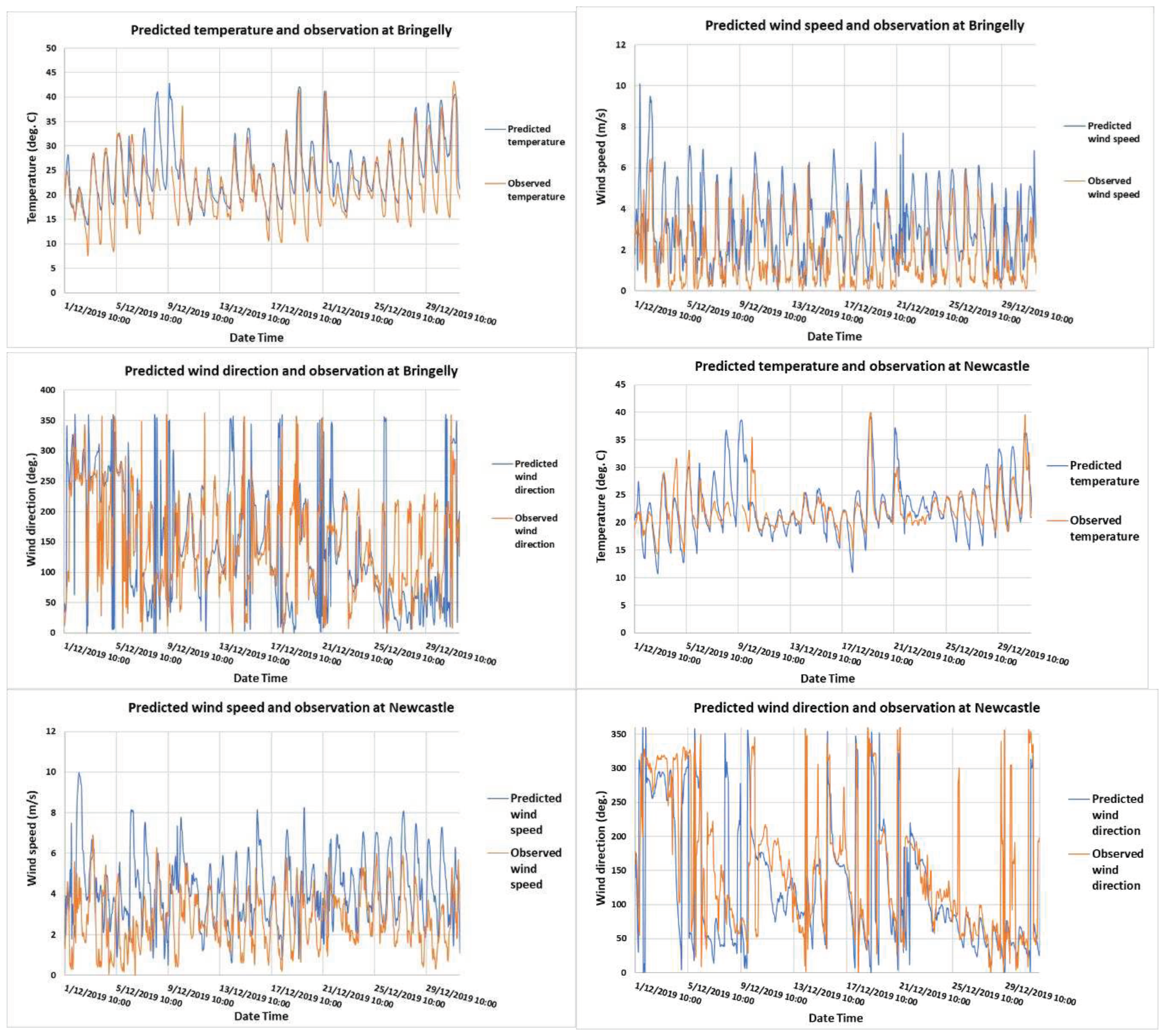
A.2 Top of the Atmosphere (TOA) shortwave radiation with wildfires simulation
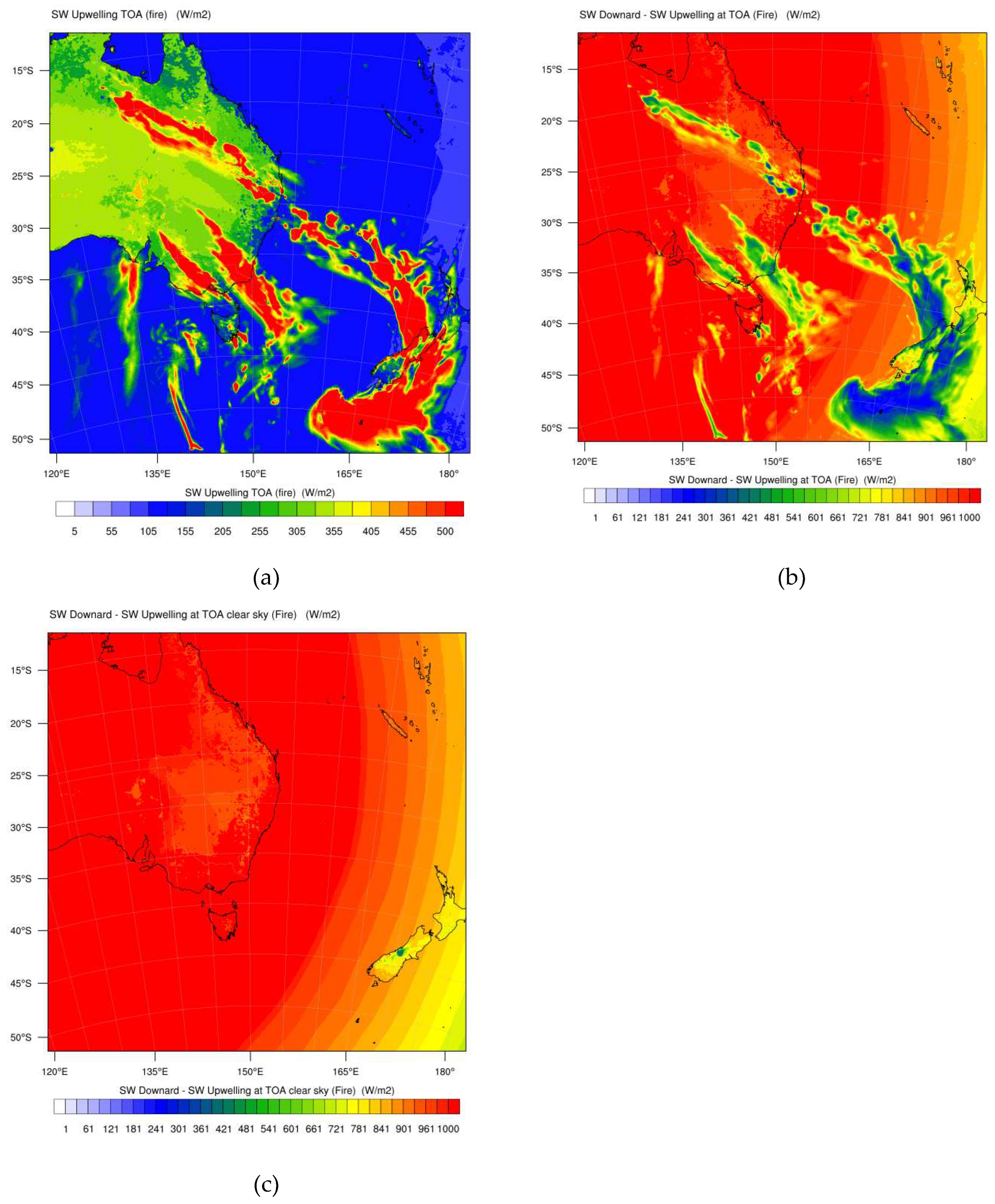
A.3 Difference in surface SW radiation with no wildfires and wildfires simulation
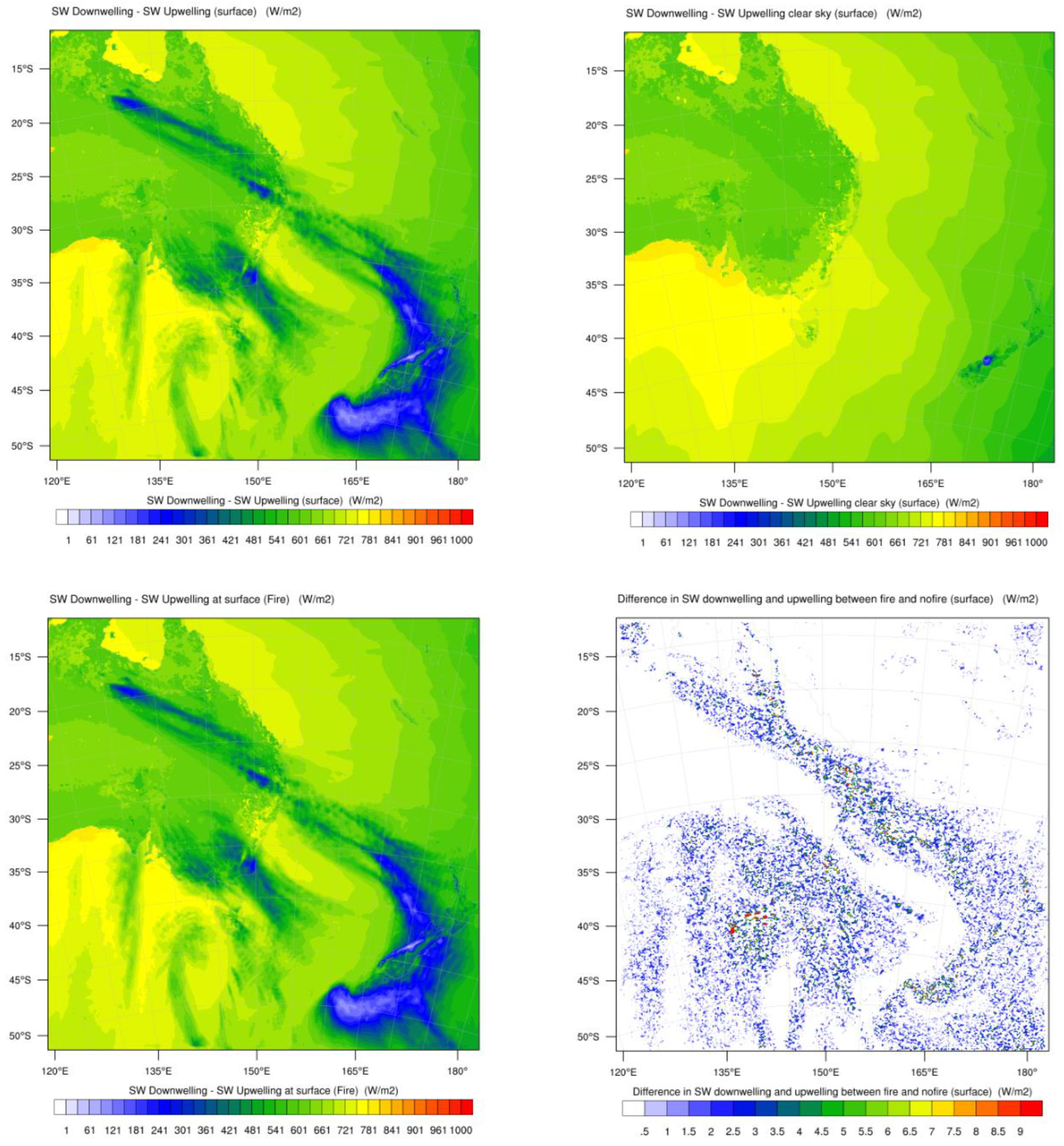
Appendix 2
References
- Feng, Y., Ramanathan, V., Kotamarthi, V., 2013, Brown carbon: a significant atmospheric absorber of solar radiation?, Atmos. Chem. Phys., 13:8607-8621. [CrossRef]
- Kuma Pani, S., Lin, N., Griffith S., Chantara, S., et al. 2021, Brown carbon light absorption over an urban environment in northern peninsular Southeast Asia, Environmental Pollution, 276:116735. [CrossRef]
- Anenberg , S., Talgo, K., Arunachalam, S., Dolwick, P., Jang, C., and West, J. 2011, Impacts of global, regional, and sectoral black carbon emission reductions on surface air quality and human mortality, Atmos. Chem. Phys. Discuss, 11, 7253–7267, 2011, www.atmos-chem-phys.net/11/7253/2011/. [CrossRef]
- Samset, B., Myhre, G., Forster, P., Hodnebrog, Ø., Andrews, T., Faluvegi , G., et al. 2016, Fast and slow precipitation responses to individual climate forcers: A PDRMIP multimodel study, Geophys. Res. Letters, 43, 6: 2782-2791. [CrossRef]
- Stjern, C., Samset, B., Myhre, G., Forster, P., et al. 2017, Rapid Adjustments Cause Weak Surface Temperature Response to Increased Black Carbon Concentrations, J. Geophys. Res (JGR Atmospheres), 122, 21: 11,462-11,481. [CrossRef]
- Takemura, T., Suzuki, K. 2019, Weak global warming mitigation by reducing black carbon emissions, Scientific Reports 9, 4419 (2019). [CrossRef]
- Lou, S., Yang, Y., Wang, H., Lu, J., Smith, S., Liu, F., Rasch, P. 2019, Black Carbon Increases Frequency of Extreme ENSO Events, J. of Climate, 32, 23: 8323–8333. 8. [CrossRef]
- Archer-Nicholls, S. et al., 2016. Aerosol–radiation–cloud interactions in a regional coupled model: the effects of convective parameterisation and resolution, Atmospheric Chemistry and Physics, 16(9), pp.5573–5594. Available at: http://www.atmos-chem-phys.net/16/5573/2016/.
- Forkel, R., Werhahn, J., Buus Hansen, A., McKeen, S., Peckham, S., Grell, G., Suppan, P. 2012, Effect of aerosol-radiation feedback on regional air quality – A case study with WRF/Chem, Atmospheric Environment, 53:202-211. [CrossRef]
- Zhao, S., Suzuki, K. 2019, Differing Impacts of Black Carbon and Sulfate Aerosols on Global Precipitation and the ITCZ Location via Atmosphere and Ocean Energy Perturbations, Journal of Climate, 32: 5567–5582. [CrossRef]
- Duc, H., Shingles, K., White, S., Salter, D., Tzu-Chi Chang, L., Gunashanhar, G., Riley, M., et al., 2020, Spatial-Temporal Pattern of Black Carbon (BC) Emission from Biomass Burning and Anthropogenic Sources in New South Wales and the Greater Metropolitan Region of Sydney, Australia, Atmosphere 2020, 11, 570. [CrossRef]
- Grell, G. and Baklanov, A., 2011, Integrated modelling for forecasting weather and air quality: a call for fully coupled approaches, Atmos. Environ., 45, 6845–6851. [CrossRef]
- Chen, D., Liu, Z., Schwartz, C., Lin, H.-C., Cetola, J., Gu, Y. and Xue, L., 2014. The impact of aerosol optical depth assimilation on aerosol forecasts and radiative effects during a wildfire event over the United States, Geosci. Model Dev., 7, 2709–2715, 2014, www.geosci-model-dev.net/7/2709/2014/. [CrossRef]
- Chaibou, A., Ma, X., Sha, T., 2020, Dust radiative forcing and its impact on surface energy budget over West Africa, Sci Rep. 2020; 10: 12236. [CrossRef]
- Singh, P., Sarawade, P., Adhikary, B., 2020a, Transport of black carbon from planetary boundary layer to free troposphere during the summer monsoon over South Asia, Atmospheric Research, 235:104761. [CrossRef]
- Singh, P., Sarawade, P., Adhikary, B., 2020b, Carbonaceous Aerosol from Open Burning and its Impact on Regional Weather in South Asia., Aerosol and Air Quality Research, 20: 419-431. [CrossRef]
- Zhao, C., Leung, R., Easter, J., Hand, J and Avise, J., 2013, Characterization of speciated aerosol direct radiative forcing over California, JGR Atmospheres, 118, 5: 2372-2388. 2. [CrossRef]
- Zhao, C., Hu, Z., Qian, Y., Leung, L., Huang, J., Huang, M., et al., 2014, Simulating black carbon and dust and their radiative forcing in seasonal snow: a case study over North China with field campaign measurements, Atmos. Chem. Phys., 14, 11475–11491, 2014, www.atmos-chem-phys.net/14/11475/2014/. [CrossRef]
- Aragnou, E., Watt, S., Duc, H., Cheeseman, C., Riley, M., Leys, J., et al., 2020, Dust Transport from Inland Australia and Its Impact on Air Quality and Health on the Eastern Coast of Australia during the February 2019 Dust Storm January 2021, Atmosphere 12(141):141. [CrossRef]
- Nguyen, H.D.; Azzi, M.; White, S.; Salter, D.; Trieu, T.; Morgan, G.; Rahman, M.; Watts, S.; Riley, M.; Chang, L.T.-C; et al. 2021, The Summer 2019–2020 Wildfires in East Coast Australia and Their Impacts on Air Quality and Health in New South Wales, Australia. Int. J. Environ. Res. Public Health 2021, 18, 3538. [CrossRef]
- Zaveri, R., Easter, R., Fast, J. and Peters, L., 2008, Model for Simulating Aerosol Interactions and Chemistry (MOSAIC), J. Geophys. Res., 113, D13204. [CrossRef]
- Zhang, J., Liu, J., Tao, S. and Ban-Weiss, G., 2015, Long-range transport of black carbon to the Pacific Ocean and its dependence on aging timescale, Atmos. Chem. Phys., 15, 11521–11535, 2015, www.atmos-chem-phys.net/15/11521/2015/. [CrossRef]
- Lin, C., Zhao, C., Liu, X., Lin, N. and Chen, W., 2014, Modelling of long-range transport of Southeast Asia biomass-burning aerosols to Taiwan and their radiative forcings over East Asia, Tellus B, 66, 23733. [CrossRef]
- Archer-Nicholls, S., 2014, Evaluated developments in the WRF-Chem model: Comparison with observations and evaluation of impacts, Ph.D. Thesis submitted to the University of Manchester, School of Earth Atmospheric and Environmental Sciences, https://www.research.manchester.ac.uk/portal/files/54558550/FULL_TEXT.PDF (Accessed on 16 April 2021).
- Papanikolaou, C.-A., Kokkalis, P., Soupiona, O., Solomos, S., Papayannis, A., Mylonaki, M., Anagnou, D., Foskinis, R., Gidarakou, M., 2022, Australian Bushfires (2019–2020): Aerosol Optical Properties and Radiative Forcing, Atmosphere, 13, 867. [CrossRef]
- Duc H., Rahman M., Trieu T., Azzi M., Riley M., Koh T., Liu S., Bandara K., Krishnan V., Yang Y., Silver J., Kirley M., White S., Capnerhurst J., Kirkwood J., 2022, Study of Planetary Boundary Layer, Air Pollution, Air Quality Models and Aerosol Transport Using Ceilometers in New South Wales (NSW), Australia. Atmosphere, 13(2):176. [CrossRef]
- Zhang, Y., He, J., Zhu, S., Gantt, B., 2016, Sensitivity of simulated chemical concentrations and aerosol-meteorology interactions to aerosol treatments and biogenic organic emissions in WRF/Chem, JGR Atmospheres, 121, 10: 6014-6048. [CrossRef]
- Curci, G., Ferrero, L., Tuccella, P., Barnaba, F., 2015, How much is particulate matter near the ground influenced by upper-level processes within and above the PBL? A summertime case study in Milan (Italy) evidences the distinctive role of nitrate, Atmos. Chem. Phys., 15, 2629–2649, 2015, www.atmos-chem-phys.net/15/2629/2015/. [CrossRef]
- Shi, Y., Hu, F., Xiao, Z., Fan, G., Zhang, Z., 2020, Comparison of four different types of planetary boundary layer heights during a haze episode in Beijing, Science of the Total Environment, 711 (2020) 134928. [CrossRef]
- Robinson, D., 2020, Accurate, Low Cost PM2.5 Measurements Demonstrate the Large Spatial Variation in Wood Smoke Pollution in Regional Australia and Improve Modeling and Estimates of Health Costs, Atmosphere, 11(8), 856. [CrossRef]
- Fierce, L., Onasch, T., Cappa, C., Mazzoleni, C., China, S., Bhandari, J., Davidovits, P., et al., 2020, Radiative absorption enhancements by black carbon controlled by particle-to-particle heterogeneity in composition, PNAS, 117 (10) 5196-5203. [CrossRef]
- Liu, D., Whitehead, J., Alfarra, M., Reyes-Villegas, E., Spracklen, D., Reddington, C., Kong, S., Williams, P., Ting, Y., Haslett, S., Taylor, J., Flynn, M., Morgan, W., McFiggans, G., Coe, H., & Allan, J., 2017, Black-carbon absorption enhancement in the atmosphere determined by particle mixing state. Nature Geoscience, 10(3), 184–188. [CrossRef]
- Wang, Y., Ma, P., Peng, J., Zhang, R., Jiang, J., Easer, R., Yung, Y., 2018, Constraining Aging Processes of Black Carbon in the Community Atmosphere Model Using Environmental Chamber Measurements, J. Adv. Model Earth Syst., 2018 Oct; 10(10): 2514–2526. [CrossRef]
- Desservettaz, M., Fisher, J, Luhar, A., Woodhouse, M., Bukosa, B., Buchholz, R., et al., 2022. Australian fire emissions of carbon monoxide estimated by global biomass burning inventories: Variability and observational constraints. Journal of Geophysical Research: Atmospheres, 127, e2021JD035925. [CrossRef]
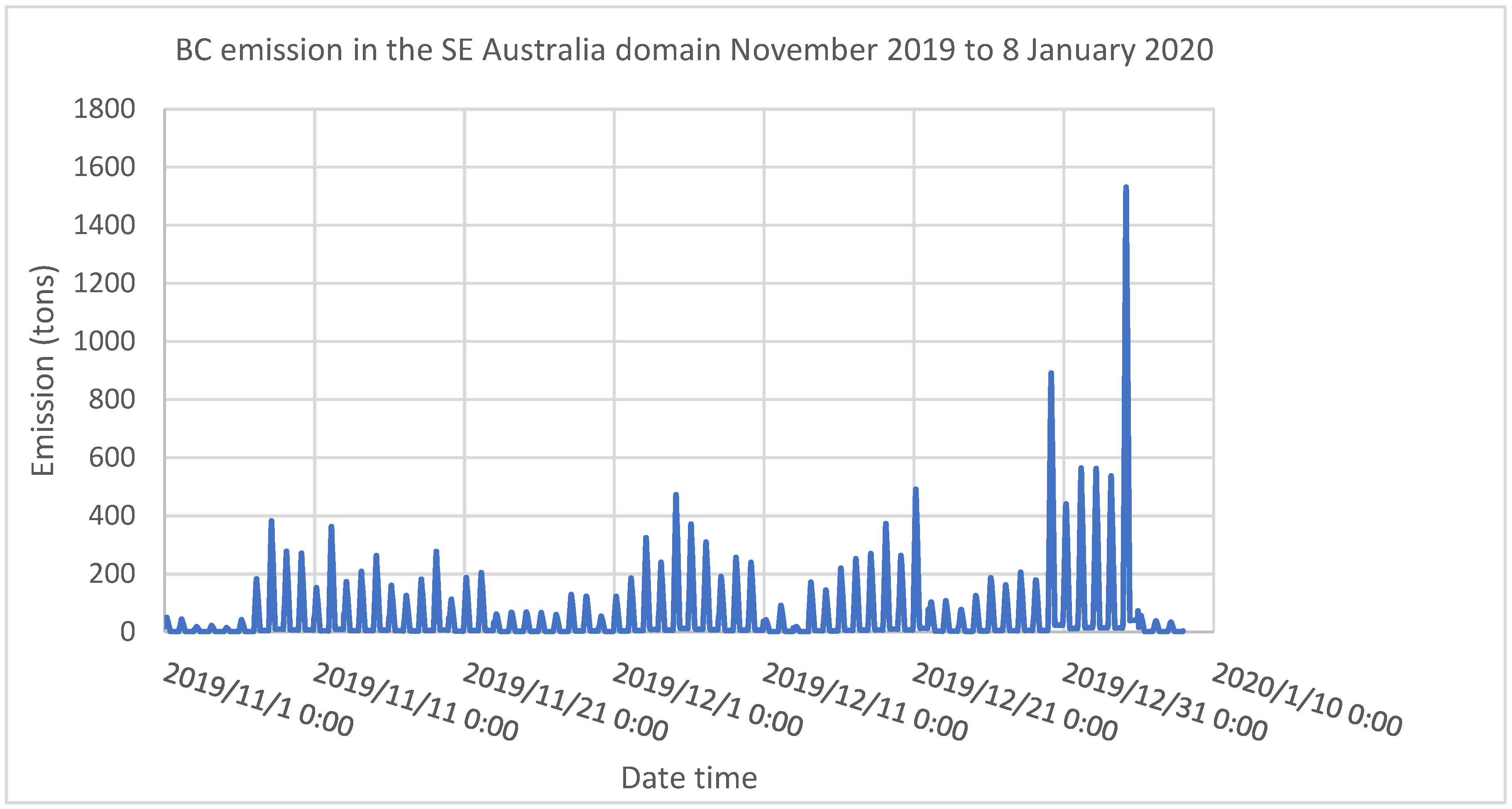
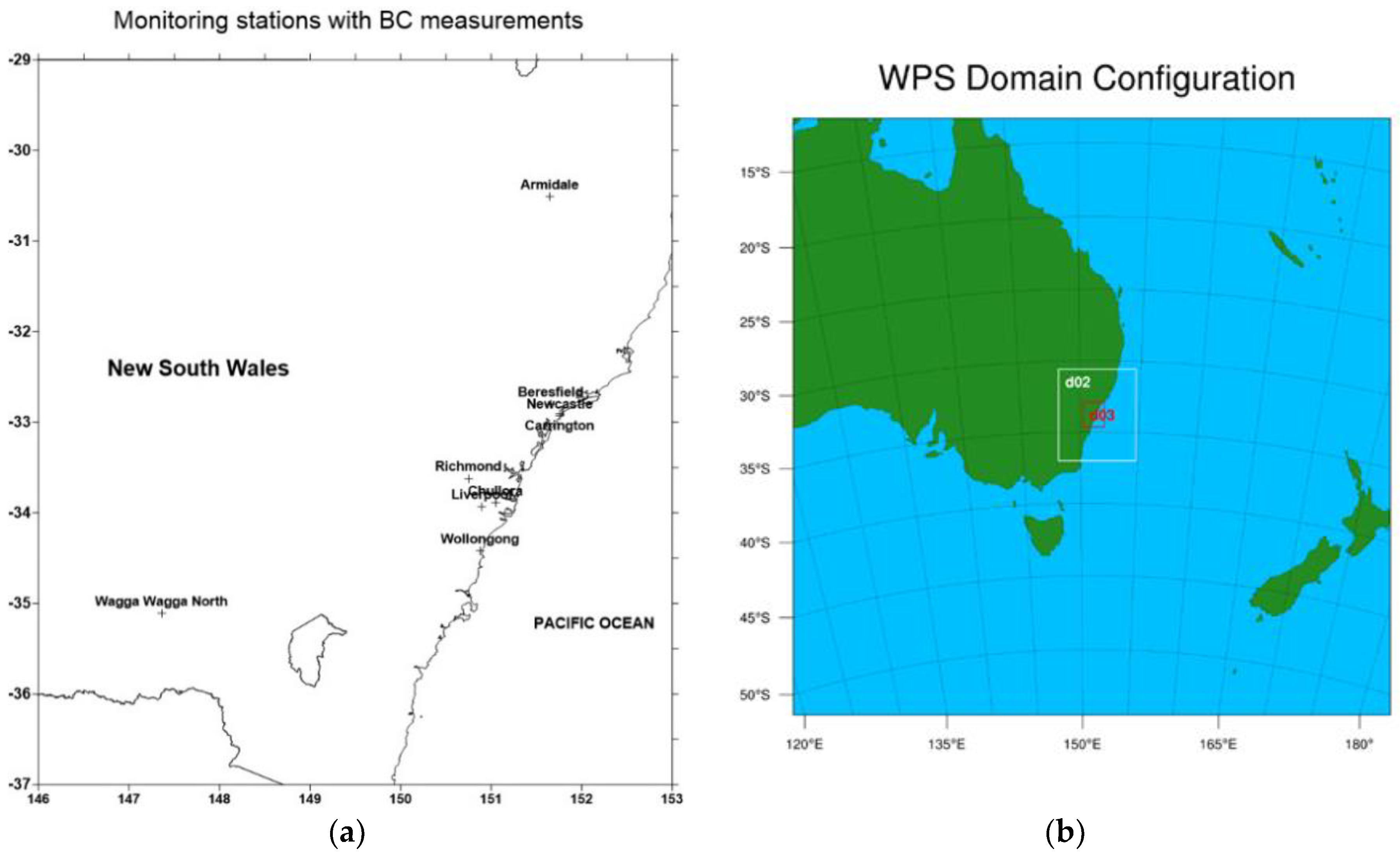
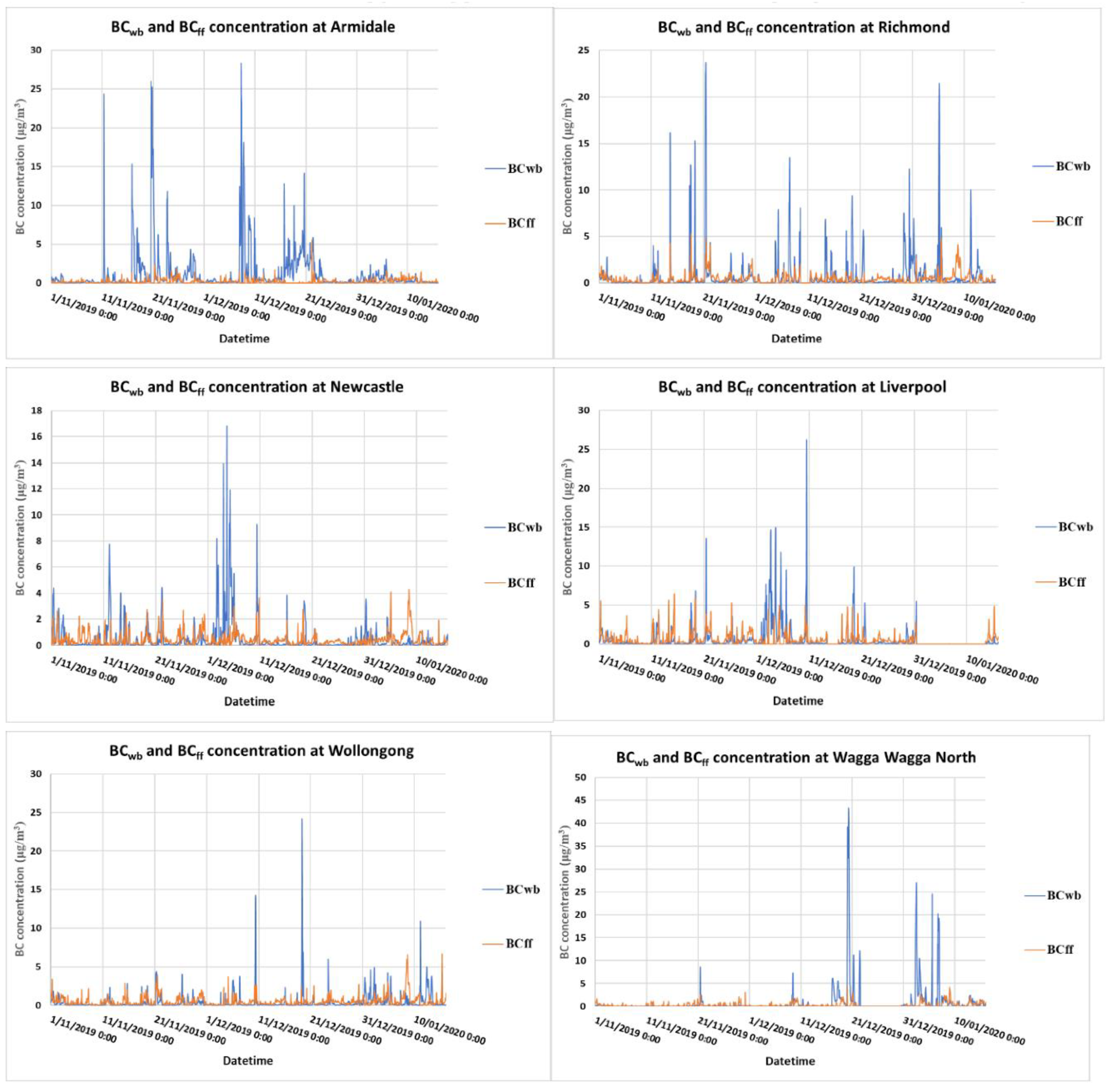
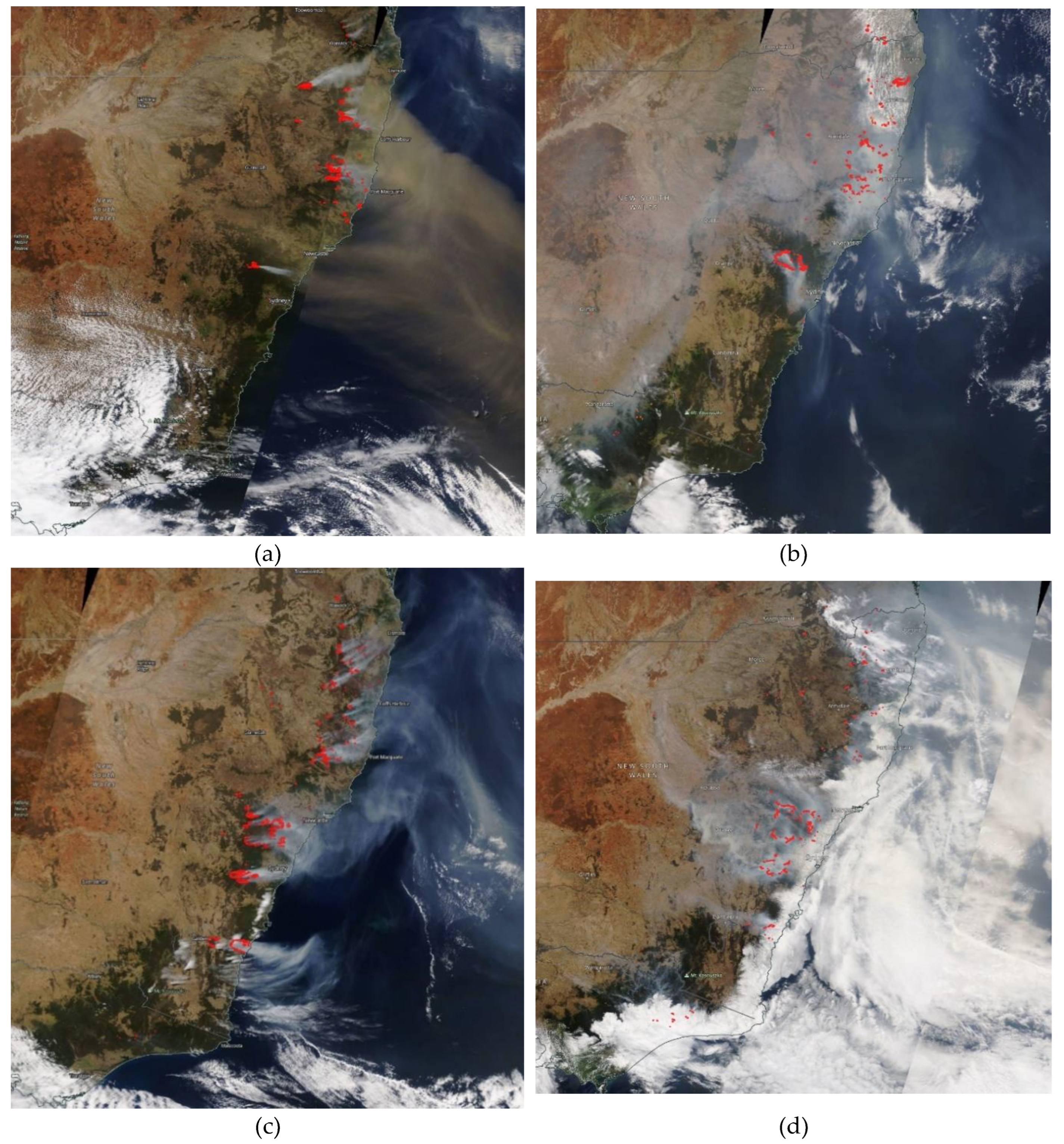
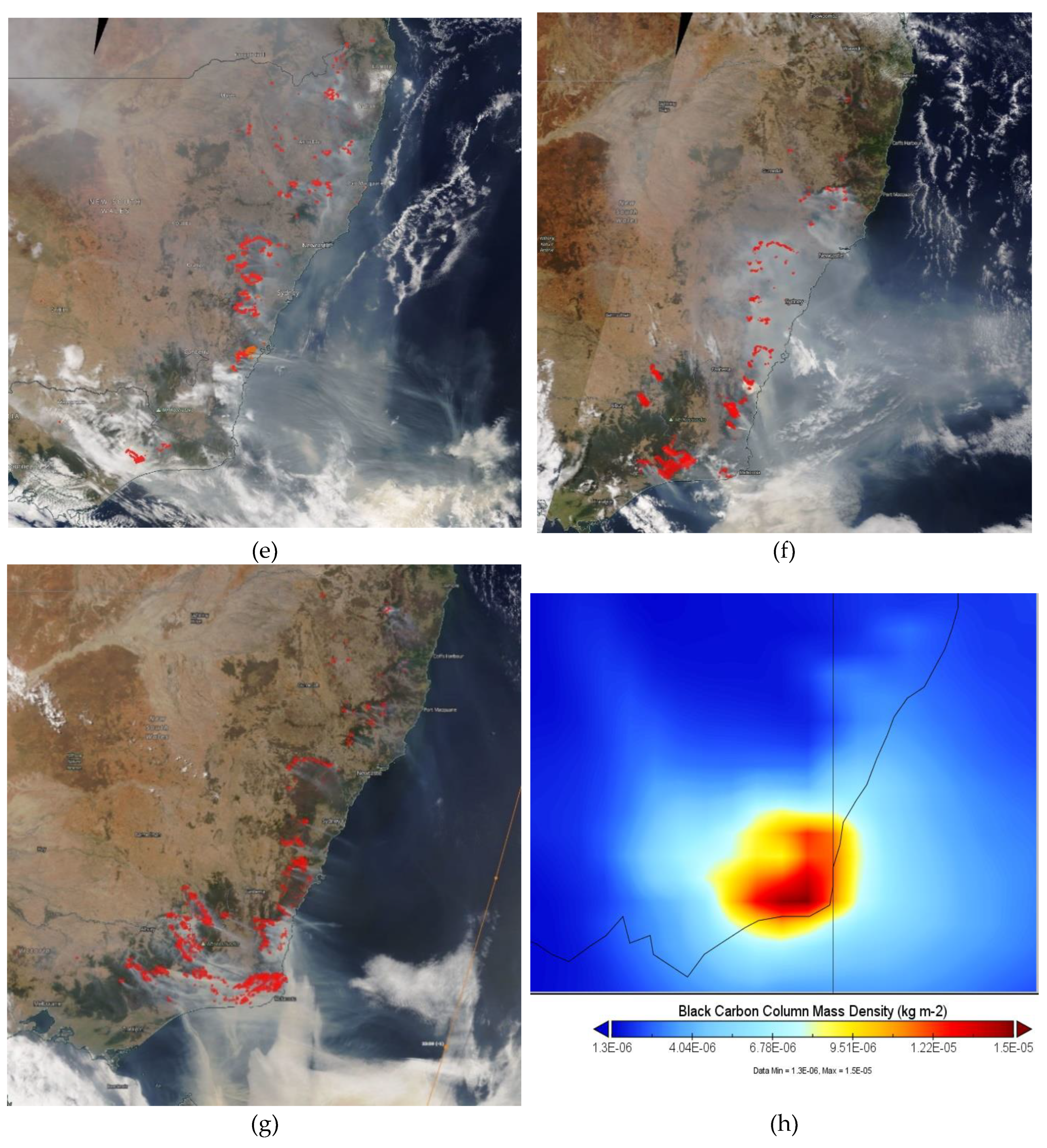
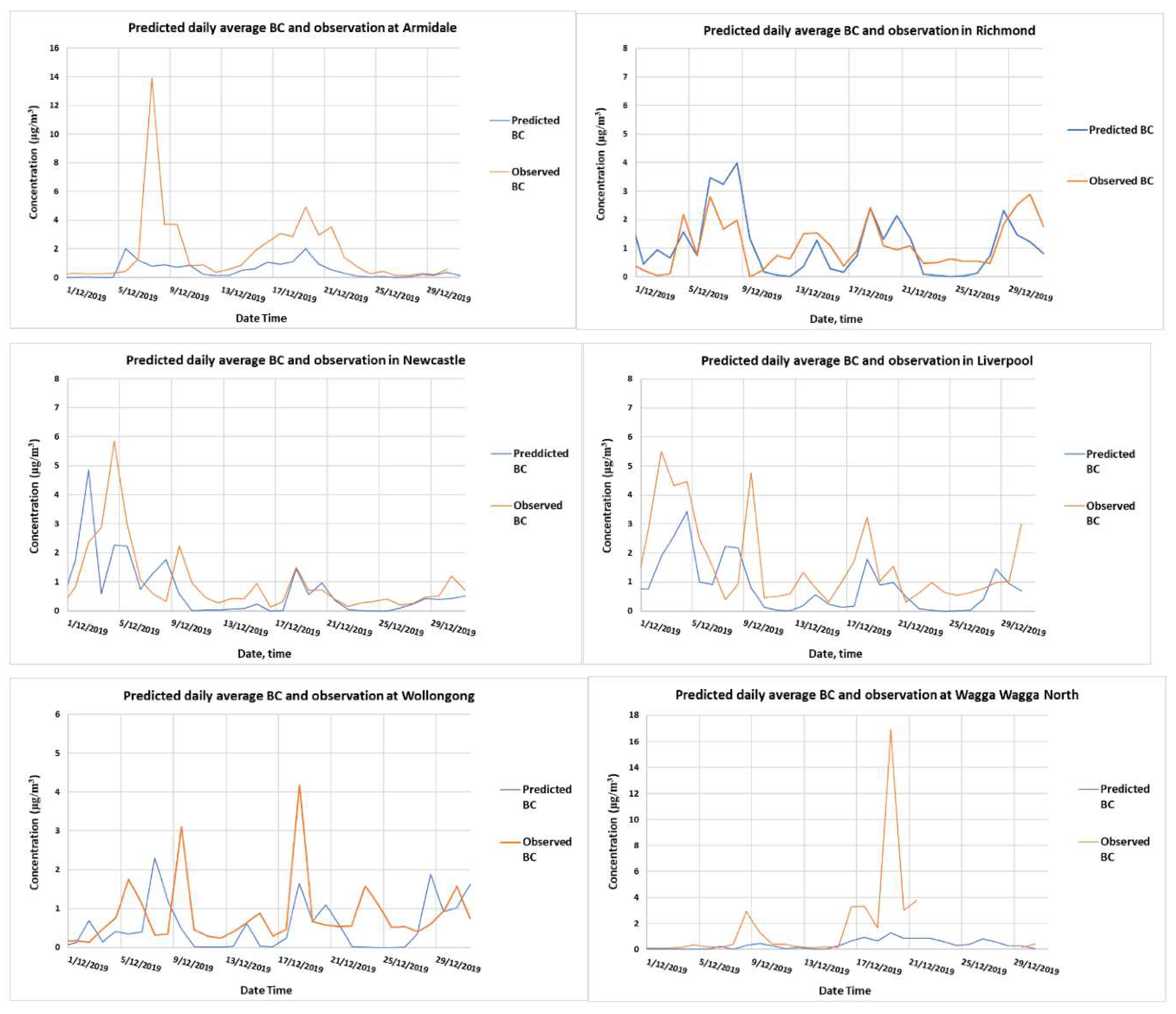
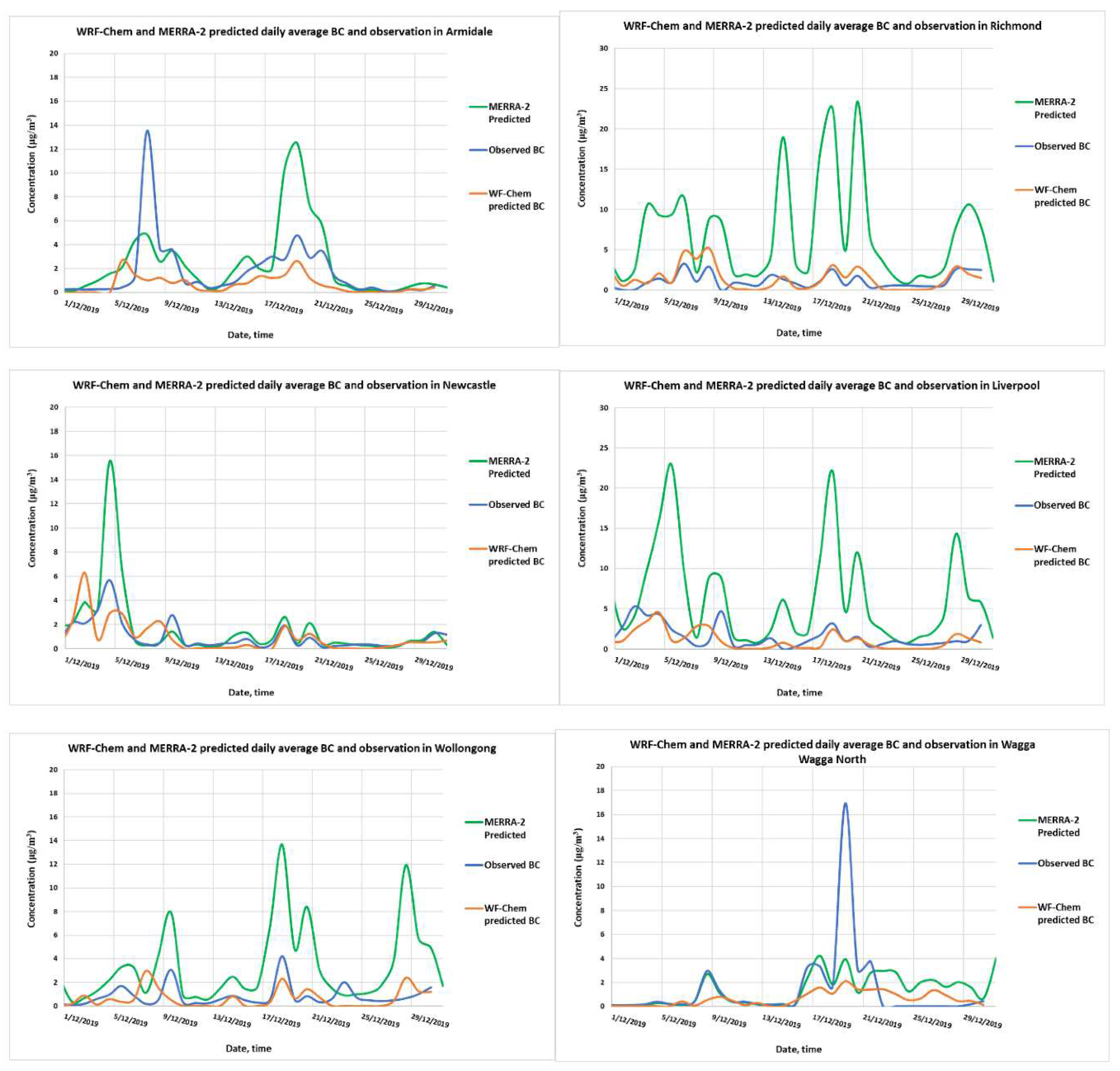
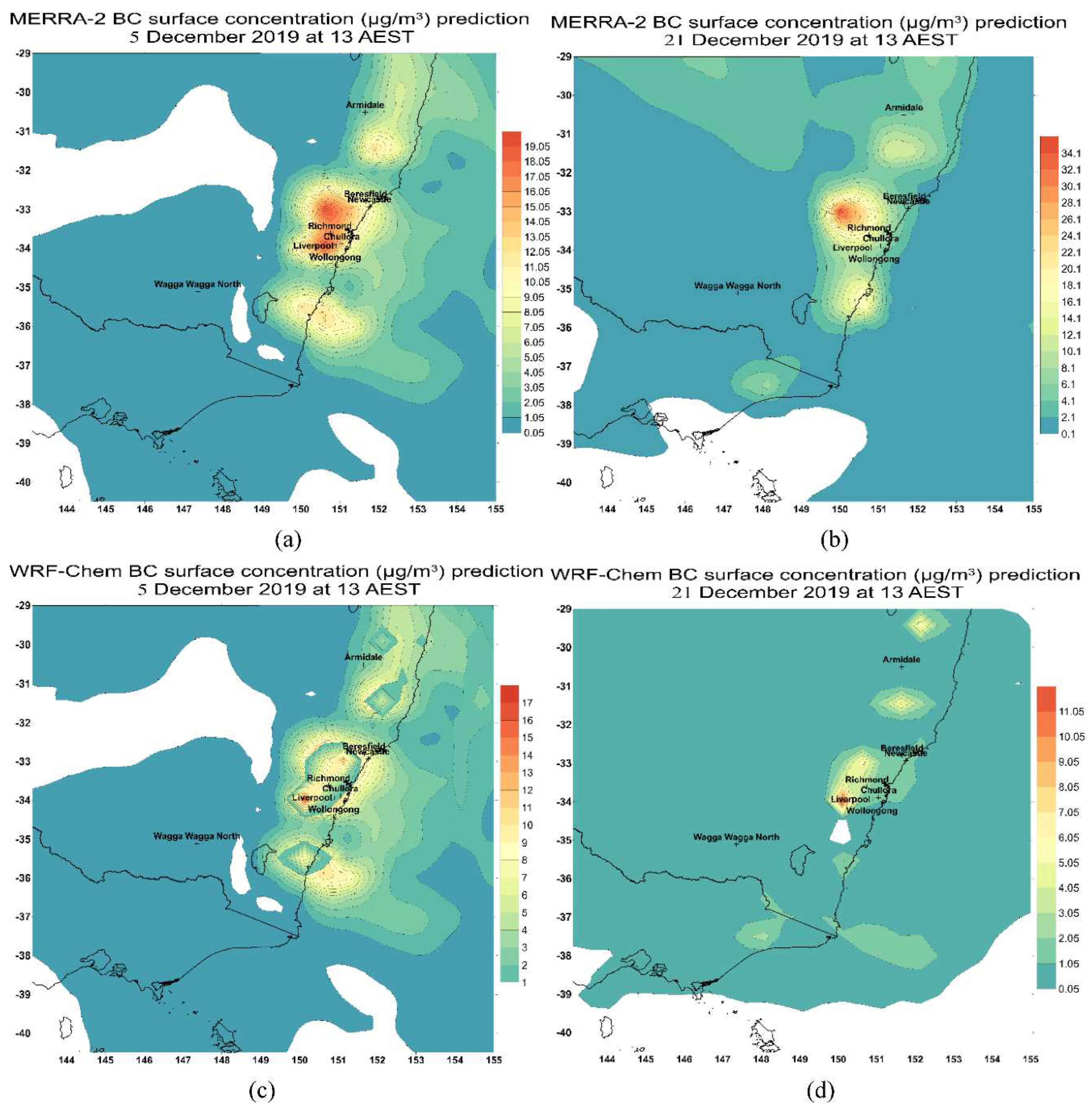

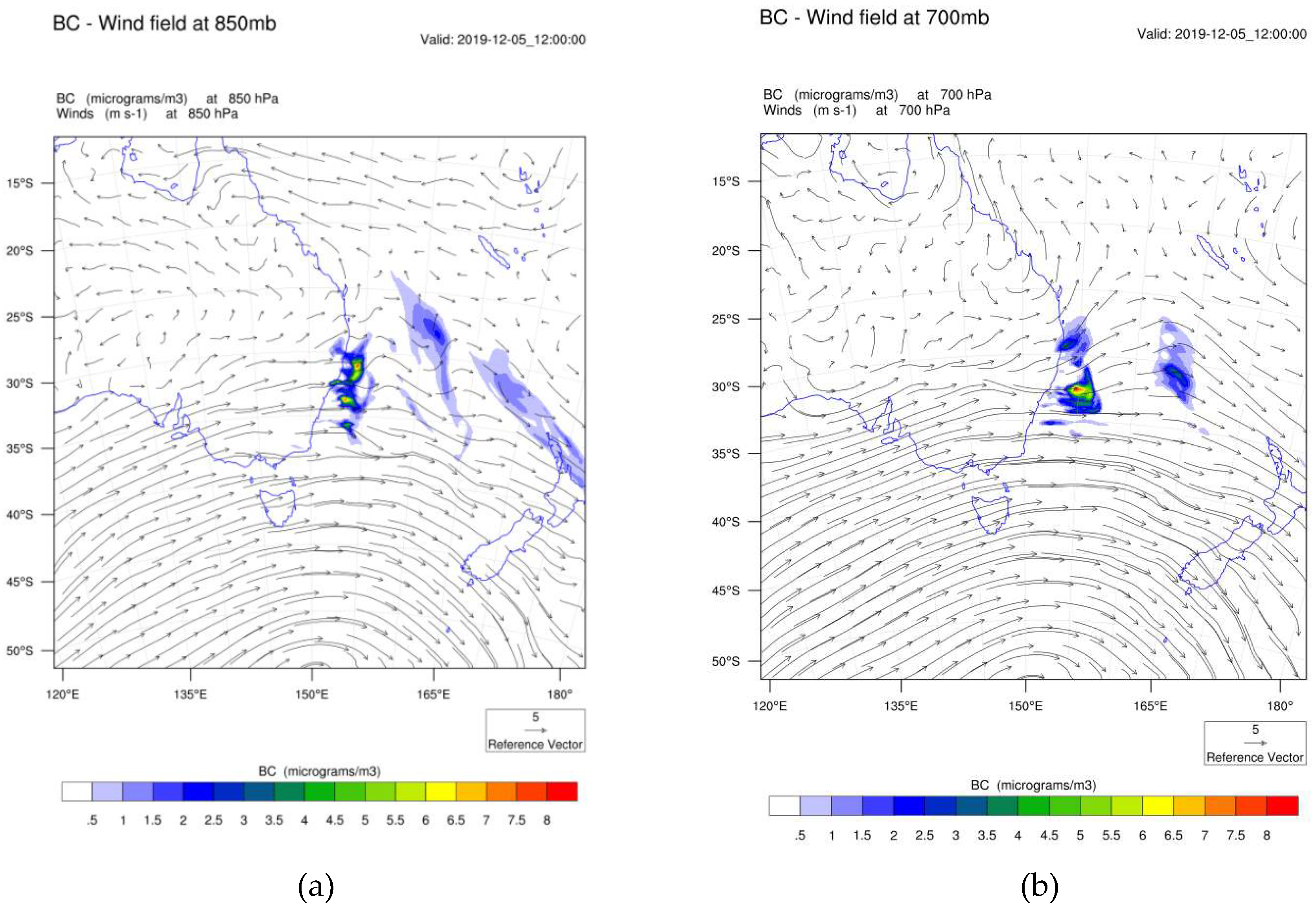
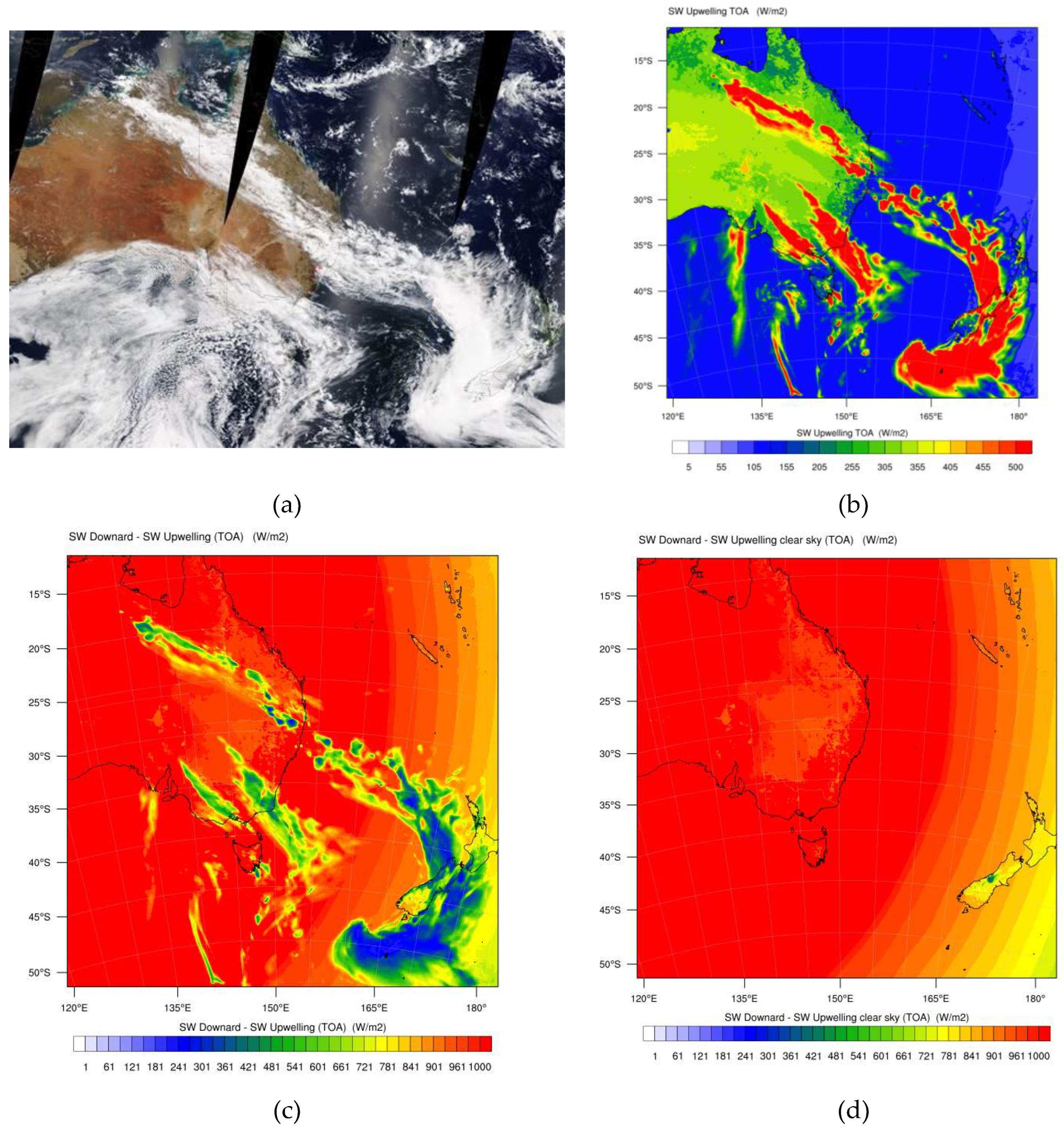
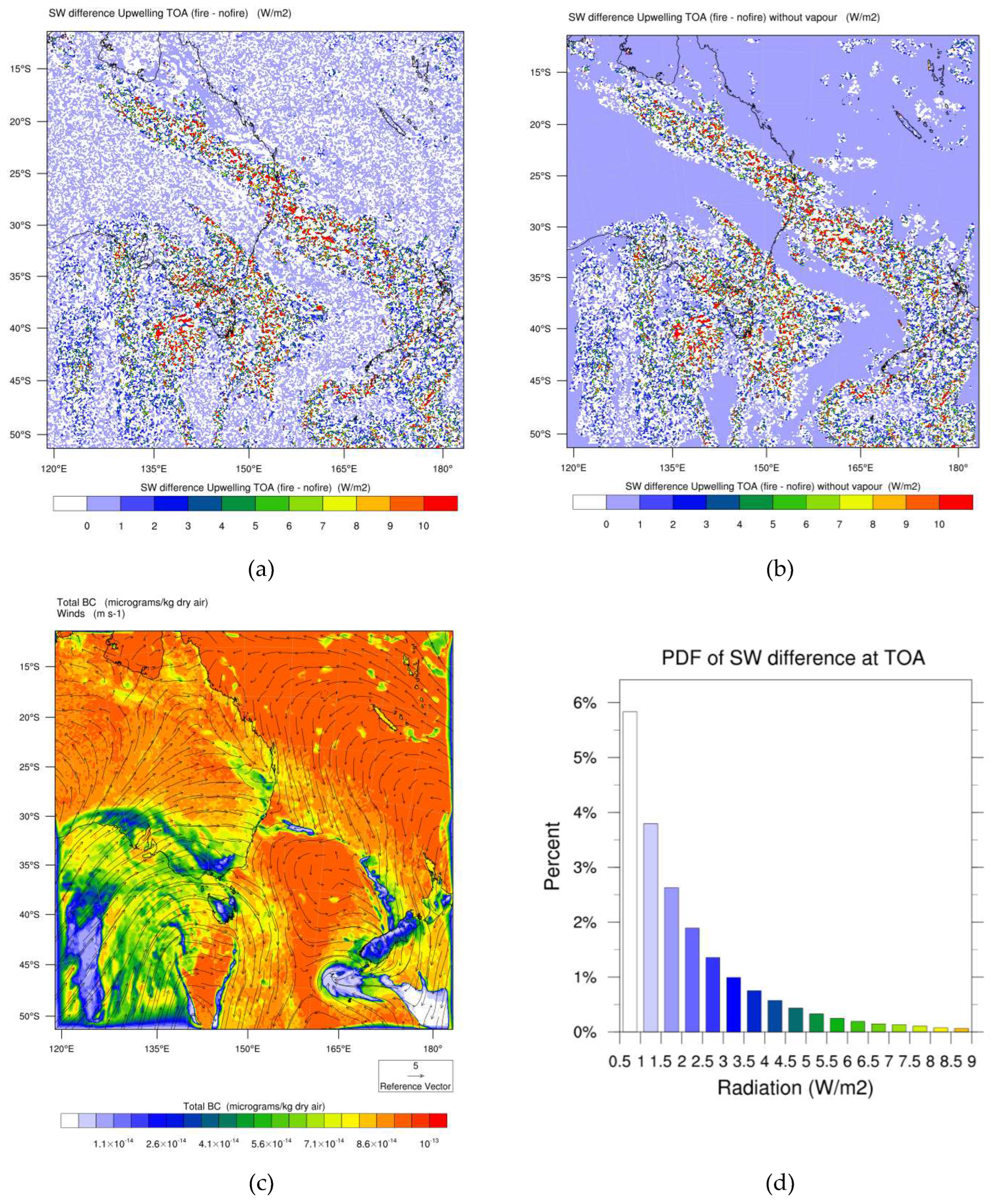
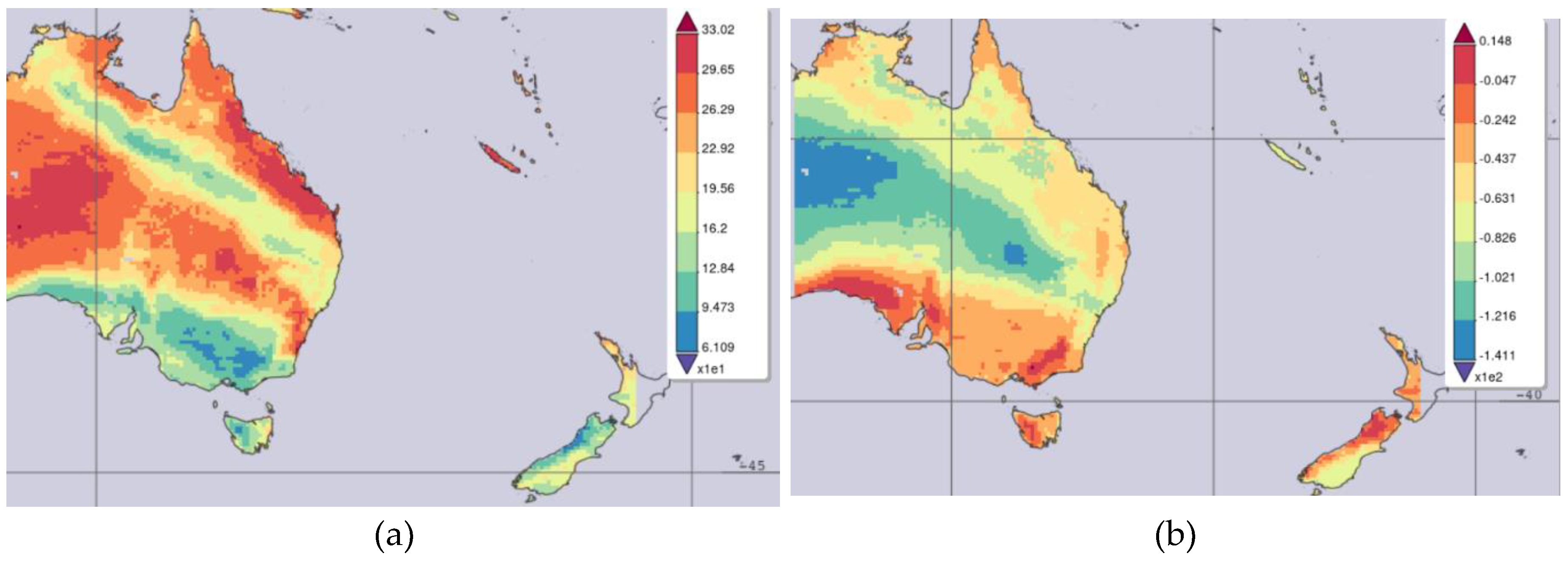
| Physical parametrisation | Namelist variable | Option | Model/scheme |
| Microphysics | mp_physics | 10 | Double-moment Morrison (modelling indirect effect on radiation due to aerosol cloud interaction) |
| Land surface | sf_surface_physics | 2 | Noah Land-Surface Model |
| Surface layer physics | sf_sfclay_physics | 1 | Monin-Obukhov similarity |
| Planetary Boundary Layer | bl_pbl_physics | 1 | YSU scheme |
| Shortwave radiation | ra_sw_physics | 4 | Rapid Radiative Transfer Model (RRTMG) |
| Long wave radiation | ra_lw_physics | 4 | Rapid Radiative Transfer Model (RRTMG) |
| Aerosol Chemistry | chem_opt | 202 | MOZART-4 chemistry and aerosol MOSAIC with aqueous chemistry |
| Dust scheme | dust_opt | 3 | GOCART-AFWA scheme |
| Aerosol extinction coefficient approximation | aer_opt_opt | 2 | Maxwell-Garnett approximation |
| Aerosol radiative feedback | aer_ra_feedback | 1 | Turn on aerosol radiative feedback with RRTMG model |
Disclaimer/Publisher’s Note: The statements, opinions and data contained in all publications are solely those of the individual author(s) and contributor(s) and not of MDPI and/or the editor(s). MDPI and/or the editor(s) disclaim responsibility for any injury to people or property resulting from any ideas, methods, instructions or products referred to in the content. |
© 2023 by the authors. Licensee MDPI, Basel, Switzerland. This article is an open access article distributed under the terms and conditions of the Creative Commons Attribution (CC BY) license (http://creativecommons.org/licenses/by/4.0/).





